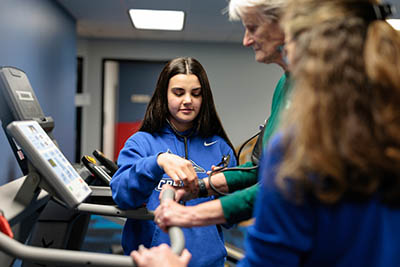
Why TikTok’s latest fitness trend is making its way into Creighton classrooms

When most people think of a workout, they picture treadmills, dumbbells or spin classes. But for Creighton physical therapy students, sometimes the most powerful lessons come from something as simple as walking.
That’s the idea behind Japanese walking, a fitness trend that has gained traction on social platforms like TikTok—and in Creighton classrooms. At its core, Japanese walking is interval training: alternating three minutes of fast-paced walking at a “somewhat hard” intensity with three minutes of slower-paced recovery walking. Repeat the cycle five times, and in just 30 minutes you’ve completed a workout that research shows can lower blood pressure, improve blood sugar and increase muscle strength.
“Unlike a gym-based program, this is something anyone can start with almost no equipment,” said Rashelle Hoffman, PT, DPT, PhD, GCS, assistant professor in the School of Pharmacy and Health Professions. “All you need is a place to walk and a timer. That could be your neighborhood, a trail or even a treadmill.”

More than a trend
Though it may sound like the latest fitness craze, Japanese walking has deep research roots. Originally studied in Japan, the method has been shown to help sedentary adults, often those who are middle-aged or managing obesity. It helps these individuals make measurable gains in cardiovascular health and endurance. Participants reported lower systolic blood pressure, improved glucose control and stronger thigh muscles after just a few months.
“Those are significant outcomes, especially for people at risk for diabetes or hypertension,” Hoffman said. “And the beauty of it is that walking feels accessible. It removes the barriers of equipment and special training. That makes it much more realistic for people to stick with over time.”
Lessons that last
For Hoffman’s students, the benefits go beyond physical fitness. Future physical therapists at Creighton learn how to evaluate and apply emerging evidence-based practices like Japanese walking in real-world contexts.
“Our students are often active themselves, so they may not always appreciate just how impactful something as straightforward as walking can be for a patient,” Hoffman said. “It’s important for them to understand not only the science but also how to recommend exercise in a way that fits into a patient’s daily life.”
That perspective is critical for Creighton-trained physical therapists, who work in settings ranging from outpatient clinics and nursing facilities to hospitals and home health. By studying innovative but practical methods like Japanese walking, students learn to design care plans that their patients can actually sustain, and that means better health outcomes.

Start slow, build steady
For those curious to try Japanese walking themselves, Hoffman emphasizes the importance of pacing.
“If you’re not walking much now, don’t jump straight into 30 minutes at four days a week,” she said. “Start with one-minute intervals, just five minutes total, and gradually build up. The key is consistency. The program only works if you stick with it.”
She also recommends avoiding outdoor sessions in extreme heat, choosing cooler times of day instead. With the right approach, Japanese walking can be tailored to a wide range of fitness levels, from beginners to seasoned walkers looking for an added challenge.
Why study physical therapy at Creighton?
At Creighton, physical therapy students in Omaha and Phoenix don’t just study rehabilitation techniques, they explore evidence-based approaches that empower patients to live healthier, fuller lives. Guided by expert faculty like Dr. Hoffman, students gain clinical experience early and often, learning to combine compassionate care with the latest research. Whether working with athletes, older adults or patients recovering from injury, Creighton-trained physical therapists graduate ready to lead in one of today’s fastest-growing health professions.
Discover where a Doctor of Physical Therapy degree from Creighton can take you.




